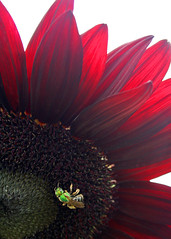 Firstly, I am beyond thrilled that author Sharon Lovejoy stopped by to visit my blog, and commented on the Sunflower House post. She has written a book called Sunflower Houses, and is the author of one of the greatest books on gardening with kids: ROOTS, SHOOTS, BUCKETS &BOOTS. We've enjoyed this book as a family, and it contains all kinds of fun and whimsical gardening projects to do with your kids. It looks like she has a whole lot of other great books out that I'll need to check out as well!
Firstly, I am beyond thrilled that author Sharon Lovejoy stopped by to visit my blog, and commented on the Sunflower House post. She has written a book called Sunflower Houses, and is the author of one of the greatest books on gardening with kids: ROOTS, SHOOTS, BUCKETS &BOOTS. We've enjoyed this book as a family, and it contains all kinds of fun and whimsical gardening projects to do with your kids. It looks like she has a whole lot of other great books out that I'll need to check out as well!Also check out The Great Sunflower Project, which will send you free sunflower seeds in return for your help in counting bees. Since bees are not only important pollinators but also struggling right now with various environmental interferences and the Colony Collapse Disorder, anything we can do to help them out (like planting beneficial flowers and tracking them) is a good thing. We've already signed up and gotten our bee-observer data sheets. The kids are excited to be helping keep an eye on our little pollinating friends.
Häagen-Dazs is also contributing to doing good things for honeybees, since many of their ingredients are honeybee dependent. So if you're looking for a good excuse to eat Häagen-Dazs ice cream, go visit their Help the Honeybees site
I also got a couple packages of Territorial Seed's Honey Bee Flower Mix seeds and I'm planting those all around the outside of our new vegetable garden space in the hopes of attracting even more bees to our garden area.
 I was happy to note that my lavender is being visited regularly by good numbers of honeybees and these cute orange-bottomed bumblebees. We used to have a beekeeper in our neighborhood and once we saw a whole swarm that had left his hive come over our house. I figure they settled somewhere in the woods near us, so we probably have a good concentration of honeybees in the area, for which I'm very grateful!
I was happy to note that my lavender is being visited regularly by good numbers of honeybees and these cute orange-bottomed bumblebees. We used to have a beekeeper in our neighborhood and once we saw a whole swarm that had left his hive come over our house. I figure they settled somewhere in the woods near us, so we probably have a good concentration of honeybees in the area, for which I'm very grateful!



1 comment:
Thanks for the link about the Sunflower project. Here in Illinois, we also have a similar site for bee spottings at http://beespotter.mste.uiuc.edu
My son and I just recently attended a presentation on bees with our unschooler group and were told that there are no longer any wild honey bees due to a mite and that they all live in man-made hives now. That if you see honey bees on your property, there must be a man-made hive within 2 miles. Another thing I found interesting is that the colony collapse disorder seems to be occuring mostly amongst beekeepers that have more than 200 hives and transport them from place to place pollinating fields of crops. My thinking is that these traveling honey bees (some of which travel 60,000 miles a year) are getting stressed by not only the travel, but also by the stress of pollinating conventionally produced, and thus heavily chemical laden plants. By the way, I love your blog and all that you write about.
Post a Comment